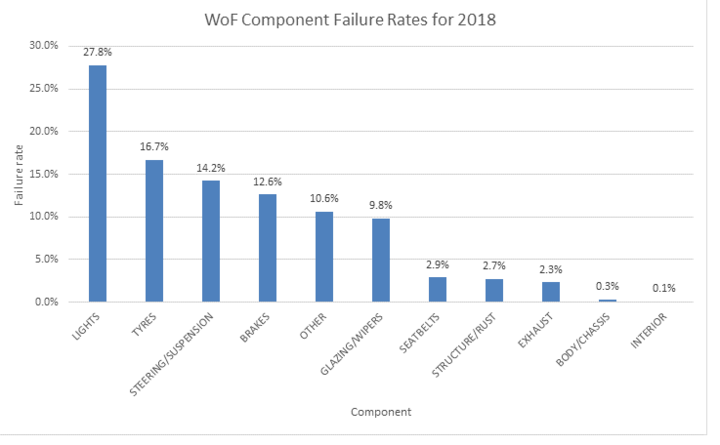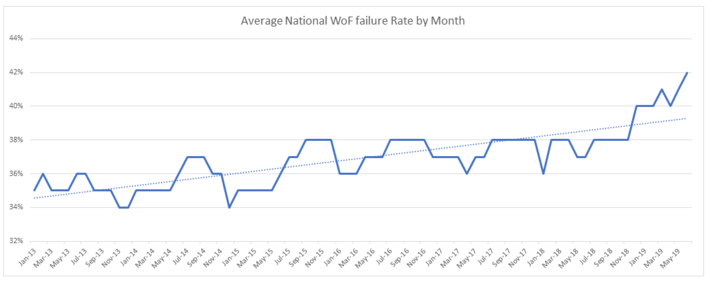
Otago is the worst region in the country when it comes to failed Warrants of Fitness.
Alongside Waikato and Gisborne, Otago, with a 46% fail rate, has the worst on average Wof failure rates while Marlborough ranks the best with 33%, according to the latest Motor Trade Association (MTA) figures.
Mechanics are speaking up about seeing increasing numbers of motorists bringing increasingly dangerous cars to garages.
In one case, a car's brake hoses were fit to burst, in another, a near-new car had tyres worn down to their steel bands.
"The percentage of vehicles that are coming in now that I'd classify dangerous would be four or 500 percent greater than previously," veteran Hamilton mechanic Paul Atkin said.
"It's not uncommon to see a dangerous car every single week."
Official figures show the number of cars failing at their first presentation for a Wof has climbed steadily in the five years since annual checks superseded six-monthly ones for most light vehicles.
It has gone from 34 percent of all inspections in 2014, to 41 percent now, a rise that represents more than a quarter million vehicles.
The government's new Road to Zero proposals that aim to reverse the rising road toll include a review of how cars get warrants of fitness.
However, the biggest Wof issuer in the country, VTNZ, and the Motor Trade Association (MTA) which covers thousands of inspectors, both point to big information gaps, in the vehicle defect and crash data that the policy makers are relying on.

"We've seen a trend of increasing warrant of fitness fails and vehicle factors contributing to fatal crashes," said the MTA's Greig Epps.
"If we can't analyse the data, if we don't have the data to analyse, we can figure out what to do next and how to fix the problem."
Wof consultant Andrea Andrews gives advice to 200 garages nationwide.
"It's collectively agreed by inspectors that the one-year warrants has significantly impacted on the road toll," she said.
To Mr Atkin, the fix would be for the government to order a return to six-monthly warrant of fitness checks.
He has numerous examples of cars being driven with serious faults:
- A late model European car had all four tyres "with steel hanging out completely around"; it had 18 months to go on its three-year new car Wof.
- A car's front brake hoses were "ready to burst". The owner returned the following day - they looked new, but it turned out he had painted them black.
- The right-front wheel of another car was locking upon braking because the disc was slipping and jamming the rotor; the Wof was not due for two months.
"There's lots of problems in the steering, in the suspension, in the braking we're picking up," Mr Atkin said.
"We've seen balljoints where how in the hell they haven't fallen to bits, I don't know."
A neighbouring garage owner, Michael Cooper of Affordable Autos in Frankton, reported similar.
"We seeing a lot more issues," Mr Cooper told RNZ.
"Ones that I do see a lot, brakes worn down to the disc rotors so they become dangerous and we've had it where people come in with no brakes at all but the pedal goes right to the floor.
"Headlights out all the time. And you know, it can be a couple of hundred dollars to change a headlight bulb, and so people just think, I just won't bother till my next warrant's up and it can be a whole year away."

The 2014 change to annual warrants resulted in an immediate rise in faults, he said.
Andrea Andrews said she was hearing from garages that the warrants problem was worse in poorer parts of the country.
"Where people could afford to get their cars repaired six monthly, the bill is now twice, maybe three times as much at the yearly stage.
"Because there's wear and tear, for example, on the tires, that leads to suspension issues as well."
The regions differ in warrant fail rates between as low as 33 percent in Marlborough and as high as 46 percent in Waikato, Gisborne and Otago.
Auckland is a relatively low 37 percent, and industry players relate that to the region's greater problem with garages giving out Wofs when they shouldn't, as revealed by the Transport Agency's suspension and revocation of more garages in Auckland than anywhere else combined.

VTNZ issues 600,000 Wofs a year.
VTNZ had offered to share data from those inspections, about the condition of the fleet, with the Transport Agency, said country manager Greg O'Connor.
"Particularly through the last 12 months when the agency's been going through it's own investigations ... they were interested but we haven't had any take-up of that offer," he said.
"The offer's still there with them and we'd love to be able to work with them on this."
On top of this, as far as he is aware there had not been any research into the impacts of the 2014 warrant change.
"Totally surprised the Wof fail rate has been allowed to increase significantly over the last five years and no real action taken to actually make a difference there," Mr O'Connor said.
VTNZ inspectors use handheld devices to enter the likes of tyre tread depths, even of cars that passed.
Others do too, and the MTA said it had been asking NZTA without success for at least five years for its thousands of members to get better digital access to the central system to - for instance - be able to record any one of the 30 reasons a tyre might fail, as opposed to simply recording 'tyre failed'.
The agency's response suggested its IT systems were unable to cope, Mr Epps said.
"The top failure areas - lights, tyres, steering and suspension and brakes - what within those categories are failing? And that's the data that's not captured by NZTA.

"Our member workshops report anecdotally that the condition of tyres are terrible, but the failure rate has remained steady."
The MTA was not pushing for a change back to six-monthly warrants, instead wanting better education of drivers, say by putting a maintenance module into driver licence testing, Mr Epps said.
The agency has yet to comment on the claims that its IT systems were inadequate or that it had not taken up VTNZ's data offer.
In a statement, it said improving the safety of the vehicle fleet was a key focus of Road to Zero.
It was working with the industry, it said, adding that motorists must take responsibility for keeping vehicles up to scratch at all times, and not merely rely on warrant of fitness inspections.












